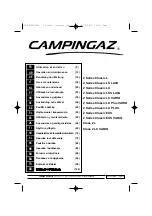
1)
DO NOT store or use gasoline
or other flammable vapors and
liquids in the vicinity of this or
any other appliance.
2)
Never store additional or
empty propane cylinders in the
grill cabinet or around the grill.
Do not store propane cylinders
indoors or on their sides. Never
use dented, rusty or damaged
propane cylinders.
3)
Children should not be left
alone or unattended in an area
where a grill is located. Place your
grill well away from areas where
children play. Do not store items
that may interest children in or
around the grill, in the cart or in
the masonry enclosure. When in
use, portions of the grill are hot
enough to cause severe burns.
4)
Never move the grill when hot.
5)
Always adhere to the required
clearances from combustibles as
detailed. The grill is designed for
outdoor use only. Never use in a
garage, building, shed, breeze-
way or other enclosed area.
6)
Gas grills are not design cer-
tified for and are not to be
installed in or on recreational
vehicles, portable trailers, boats
or any other moving installation.
7)
Have an ABC Fire Extinguisher
accessible — never attempt to
extinguish a grease fire with
water or other liquids.
8)
Store your grill in a well-ven-
tilated area. Remove the L.P. cyl-
inder, if so equipped, and store
it outdoors in a well-ventilated
area away from heat and away
from where children may tam-
per with it.
9)
Keep any electrical supply
cord and the fuel supply hose
away from any heated surfaces.
Electrical cords should be placed
away from walkways to avoid
tripping hazard.
10)
Do not repair or replace
any part of the grill unless spe-
cifically recommended in this
manual. Other service should be
performed by a qualified tech.
11)
If the grill is installed by a
professional installer or techni-
cian, be sure that he shows you
where your gas supply shut-off is
located. All gas lines must have
a shut-off that is readily and eas-
ily accessible. If you smell gas,
check for gas leaks immediately.
Check only with a soap and
water solution. Never check for
gas leaks with an open flame.
Precautions for Installation and Storage
As a high-performance gas ap-
pliance, your Lynx grill requires
significant amounts of air to sup-
port the combustion process.
Your grill has been engineered
to take air in through the con-
trol panel area, and exhaust the
combustion byproducts out
through the gap between the
front and rear hoods (see figure
3-2 at right).
Using your grill in windy condi-
tions can disrupt the proper flow
of air through your grill, lead-
ing to reduced performance, or
in certain severe cases, causing
heat buildup in the control panel
area. This can lead to problems
such as having the control knobs
melt, or burn hazards when the
control panel surfaces become
too hot to touch.
During windy conditions, it is
best if you don’t use your grill.
If you have a freestanding grill,
it is best to position the unit so
the prevailing wind blows into
the front control panel (or at
your back), thus supporting the
proper airflow. Winds hitting
the back of the grill directly are
the most likely to cause prob-
lems, although wind blowing
along the hood gap can also be
problematic.
Please note that damage to
your grill resulting from use
in windy conditions, such
as melted knobs or igniter
wires, or control panel dis-
coloration from heat build-
up, are excluded from war-
ranty coverage.
SPECIAL NOTE ON USING YOUR GRILL IN WINDY CONDITIONS
Summary of Contents for L27 Series
Page 1: ... Ê Care Use of Your Lynx Professional Grill ...
Page 33: ...29 Parts Diagram ...
Page 34: ...30 Parts List ...
Page 35: ......







































